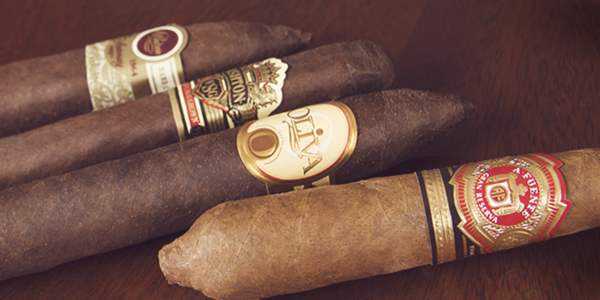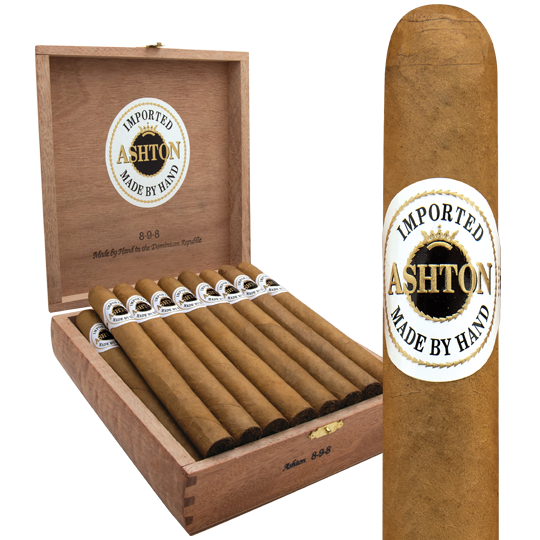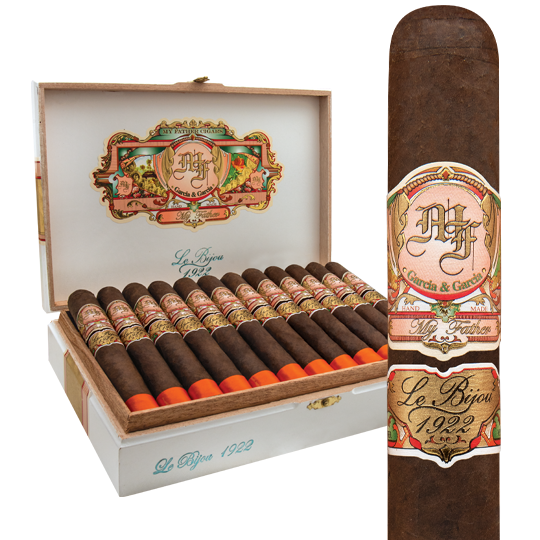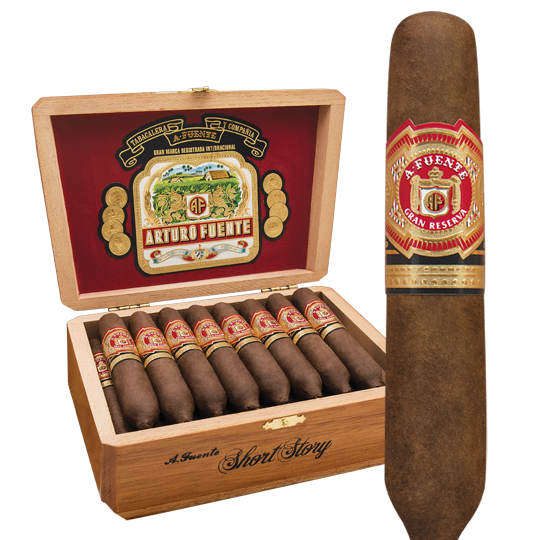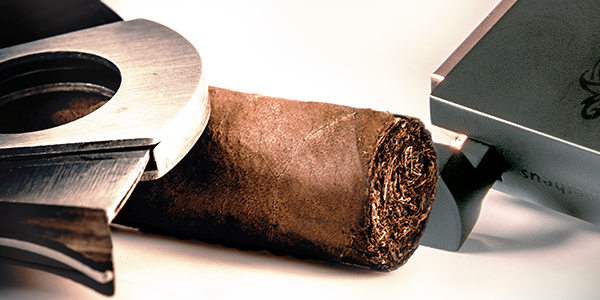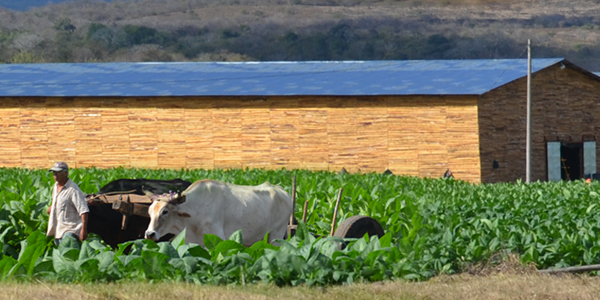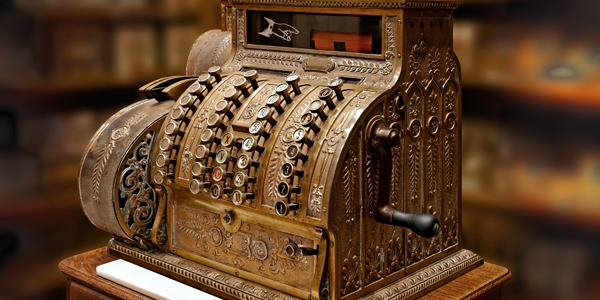Guide to Different Types of Cigar Shapes and Sizes
The word vitola is Spanish for shape. That’s why you’ll often see cigar shapes referred to as vitolas. The shape and size of a premium cigar influences its intensity, how long it will burn, and which consumers will buy it. The different binder, filler, and wrapper tobaccos that make up a cigar are combined in different ratios depending on the cigar’s size. A cigar’s wrapper leaf plays a big role in its taste.
We all have different preferences for cigar sizes and sometimes our preference for size and shape is determined by the blend. Here’s an overview and a general guide to different cigar shapes and sizes to illuminate why certain shapes may taste the best to you.
The Basics
How to Size a Cigar
Cigar sizes are measured in two dimensions: length and ring gauge. Length is measured in inches. Ring gauge is measured in 64ths of an inch – the same way your fingers are measured when you are fitted for a wedding ring, for example.
Premium handmade cigars are anywhere from 3 ½ to 4 inches in length up to 9 inches (or longer in rare cases). Most cigars are between 4 ½ and 7 ½ inches long. Cigar ring gauges can vary from 34 (very thin) up to 80 (extremely thick). Most cigars range from 38 to 60 in ring gauge. You can follow our cigar size chart for a general guide to different cigar shapes.
Does Cigar Size Affect Strength?
While size matters, it is not an absolute indication of flavor or strength. Those are matters more influenced by the tobacco used in making whatever size cigar you try. You should know, however, that thinner cigars tend to burn hotter than those of a larger ring gauge. A bit of physics comes into play. Size matters when comparing a thinner cigar to a fatter cigar containing the same blend of binder, filler, and wrapper tobaccos.
Don Pepin Garcia Original in a long and slender Lanceros (7 ½ x 38) will be a much different experience than a big ring gauge Toro Grande (6 x 62), due to the wildly differing ratios of filler and wrapper tobaccos that go into making each size.
In a thinner cigar like the Lanceros, the wrapper will be more dominant in what you taste because there is a smaller ratio of binder and filler tobaccos on the inside. The Toro Grande, however, is much thicker and the taste of the wrapper is diluted by a higher proportion of filler tobaccos. In a thick cigar, the filler will impact the taste to a larger extent since there’s more of it -- even though the wrapper will still have a noticeable influence on the cigar’s flavor and power.
Types of Cigar Shapes
There are two basic categories of cigars: Parejos (straight shapes) and Figurados (tapered shapes).
The Parejo is a straight cylinder with even sides and an open foot (the end you light). The cigar needs to be cut at the head (the end you put in your mouth). Parejos can be round or box-pressed. Box-pressed indicates the length of the cigar has been compressed into a square.
The other shape is a Figurado, a cigar that is not a straight cylindrical form; usually the head is tapered and, sometimes, both ends are finished in a sharp point. Here are the different main vitolas (AKA cigar shapes) in each category.
Parejos: Straight-Shaped Cigars
Corona
This is pretty much the standard cigar. It’s usually in the 5 1/2 to 6-inch length, with a ring gauge between 42 and 44. The Ashton Corona is a great mild cigar to start out with. Or try the Davidoff Grand Cru #2. If you prefer something a little bolder, give the Partagas #2 a shot.
Churchill
This was named after Winston Churchill and is a longer version of the corona, about 6 3/4 - 7 inches, with a slightly larger ring gauge in the 48-50 range. Almost every manufacturer offers a Churchill. The Romeo y Julieta Churchill from Cuba popularized the shape. The Honduran Romeo y Julieta Reserve Churchill scores highly, as do the San Cristobal Elegancia Churchill and the San Cristobal Revelation Triumph, both Nicaraguan. The Ashton ESG 20-Year Salute is a superb all-Dominican Churchill.
Corona Gorda
This shape traditionally is found at about 5 5/8 inches in length, with a ring gauge around 46, creeping up to a 48. The Punch Punch is a classic version of this vitola, as is the Ashton Symmetry Prism, which blossoms with tremendous complexity via a mix of both Dominican and Nicaraguan tobaccos beneath a glistening Cuban-seed wrapper grown in Ecuador.
Double Corona
The icon here probably is the Cuban Hoyo de Monterrey Double Corona. Traditionally, this cigar is between 7 ½ and 8 ½-inches by a ring gauge of 49 to 52. The Honduran version is slightly smaller at 6 ¾ x 48. I like the Ashton Heritage Double Corona out on the golf course. At 7 x 52, it lasts the whole 18 holes. Unless I four-putt my usual number of greens.
Petit Corona
The mini-me of Coronas. The Cuban Montecristo No. 4, 5 1/8 x 42, and the Ashton Cabinet Tres Petit, 4 3/8 x 42, are brilliant standard bearers of this shape. Treat yourself to an amazing pre-dinner smoke.
Gordo
This is the offensive lineman of cigars. We’re talking about a 60-plus ring gauge with lengths of between roughly six and seven inches. Some have even been rendered in a bursting 8 x 70 format! These big boys have become a phenomenon in recent years. Fans of Nicaraguan smokes love the Padrón 1964 Anniversary #4 and the La Aroma de Cuba Reserva Pomposo, both 6 1/2 x 60. A Gordo will often deliver a big, cool-burning draw that progresses slowly.
Lancero
The first Lancero was the Cohiba (7 1/2 x 38) known as “El Laguito No. 1,” named for the Cuban factory where it was made. Davidoff followed with the Cuban Davidoff #1 (no longer made). And so was born a new vitola in the 1960s. One additional interesting tidbit is that Lanceros often are capped with a pigtail curled from the wrapper leaf. Again, Lanceros classically measure 6 1/2 to 7 1/2 inches by between a 38 and 42 ring gauge. As mentioned, many traditionalists love the Lancero shape because most of the flavor from a cigar resides in the wrapper leaf, and in this format the wrapper’s nuance is truly emphasized.
Panatela
This cigar is long, from 6 1/2 to 7 inches, and skinny with a 28 to 38 ring gauge. At 38, Panatelas tend to be referred to as Lanceros at times. Put on your white linen suit and sport this pencil-thick cigar between your fingers as you walk down the street. The Davidoff Signature #2 is an elegant smoke. Try the My Father #4 and the Tatuaje Black Petit Lancero as well.
Lonsdale
This cigar is longer than a Corona and more buxom than a Panatela. Classically, the Lonsdale weighs in at about 6 1/2 inches by 42. A great example that is slightly bigger is the Montecristo White Especial #1 at 6 5/8 x 44.
Robusto
Probably the most popular shape in the U.S. today, this short, plump cigar is usually between 4 3/4 and 5 1/2 inches long with a ring gauge between 48 and 52. The Cohiba Robusto, 4 7/8 x 50, is Cuba’s entry here. Ashton Magnum, 5 x 50, and Arturo Fuente Don Carlos Robusto, 5 1/4 x 50, are quintessential examples from the Dominican Republic.
Toro
This is best seen as a Robusto with a glandular problem. A Toro reaches about 6 x 52 and is a shape that is also extremely popular in the U.S. Ashton ESG 23-Year Salute is a wonderful Toro with an extra quarter-inch to it and plenty of rich and creamy, graham-cracker notes, while Ashton Double Magnum is an ideal mild Dominican blend and an approachable Connecticut Shade wrapper.
Figurados: Tapered-Shaped Cigars
Belicoso
Call it a short Pyramid or Torpedo if you like, but the Belicoso is best understood in contrast to other tapered-head cigars. This one takes a short turn to a point and is blunter than its sister shapes. The Ashton VSG Belicoso #1, at 5 1/4 x 52 is an exemplary rendition from the Dominican Republic. Flor de las Antillas Belicoso comes in a little heftier, at 5 1/2 x 54 in a tasteful all-Nicaraguan blend.
Torpedo
This shape, today, is often also called a Pyramid, although classically there is a difference. The Cuban Cuaba Millenium is still a true torpedo, with a closed foot and a medium taper at the head. To be clear, the Pyramid shape differs in that it has a much longer taper to its pointy head, like the Ashton ESG 22-Year Salute, or the Arturo Fuente Don Carlos #2. Cigar Aficionado’s ‘#1 Cigar of the Year’ in 2015 was My Father Le Bijou 1922 Torpedo Box Press, a hearty 6 1/8 x 52 profile of earth, coffee beans and pepper. The beauty of this shape is that it’s easy to hold between your lips and in a larger ring gauge. That’s the case for most tapered cigars. For cigar lovers today, and for our purposes, the names Torpedo and Pyramid are practically interchangeable.
Perfecto
This cigar is distinctive in that it is tapered at both ends and has a closed foot, though some are cut open right at the tip. Perfectos are more about shape than size, as they vary tremendously among and within brands. Arturo Fuente Hemingway is the best example of this shape. Iconic Perfectos in the Arturo Fuente Hemingway line include the Short Story which measures 4 x 49, the Signature at 6 x 47, and the Classic in a 7 x 48, each of which express the blend of a Cameroon wrapper over aged Dominican long-fillers with remarkable distinction.
As you develop your taste for premium cigars, it is likely you’ll discover that certain blends are more appealing or palatable in different shapes than others. You may find you enjoy a milder smoke in a more concentrated, petit format, while larger, big ring-gauge cigars lend approachability to a blend that is more intense. Keep track of the cigar sizes you like, and dislike, the most. Knowing a format that’s best for you in a given blend provides tremendous insight you can apply as you build a collection and develop your palate. In closing, you should know that my friend has not yet lost those 20 pounds. He’s still smoking though! Just not any of those skinny sticks.

